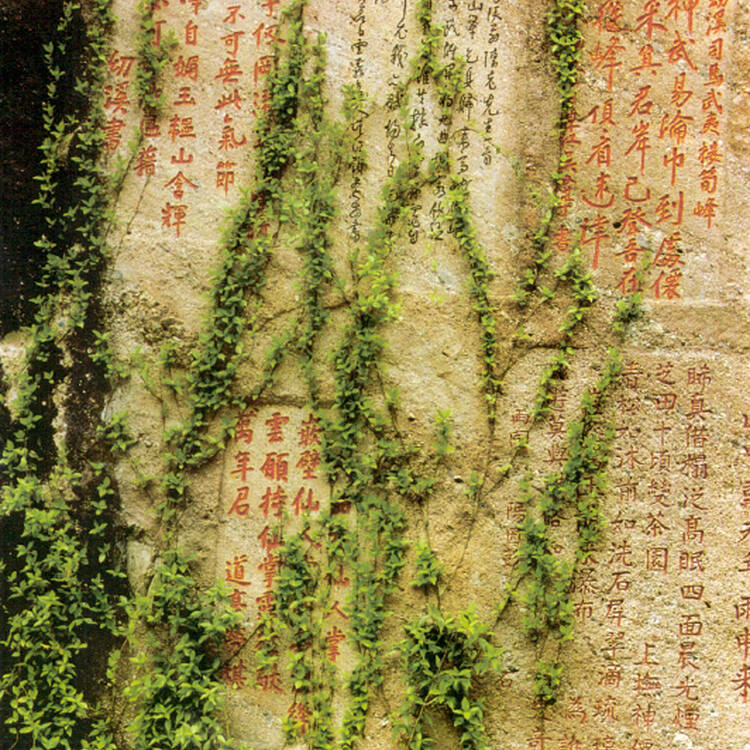Mount Wuyi
Mount Wuyi
Mount Wuyi is the most outstanding area for biodiversity conservation in south-east China and a refuge for a large number of ancient, relict species, many of them endemic to China. The serene beauty of the dramatic gorges of the Nine Bend River, with its numerous temples and monasteries, many now in ruins, provided the setting for the development and spread of neo-Confucianism, which has been influential in the cultures of East Asia since the 11th century. In the 1st century B.C. a large administrative capital was built at nearby Chengcun by the Han dynasty rulers. Its massive walls enclose an archaeological site of great significance.
Description is available under license CC-BY-SA IGO 3.0
Mont Wuyi
La région du mont Wuyi est considérée comme la plus exceptionnelle pour la conservation de la biodiversité dans le sud-est de la Chine. C'est un refuge pour bon nombre d'espèces réliques, dont beaucoup sont endémiques de la Chine. La beauté sereine des gorges spectaculaires de la rivière aux Neuf Coudes avec ses nombreux temples et monastères – dont plusieurs sont en ruine – a été le cadre du développement du néo-confucianisme qui s'est répandu et a fortement influencé les cultures d'Asie orientale à partir du XIe siècle. Au Ie r siècle av. J.-C., la localité voisine de Chengcun a été une grande capitale administrative, construite par la dynastie Han. Derrière ses murailles massives se trouve un site archéologique de grande importance.
Description is available under license CC-BY-SA IGO 3.0
جبل وويي
تُعتبر منطقة جبل وويي الأكثر استثناءً لناحية المحافظة على التنوّع البيئي في جنوب شرق الصين. وهي موئل العديد من الأصناف الطبيعيّة الصامدة التي كان العديد منها مستوطناً في الصين. وشكّل نهر المنعطفات التسعة بمضائقه الأخاذة ومعابده وأدياره، وقد استحال معظمها مجرّد أطلال، الإطار الطبيعي لتطوّر الكونفوشيوسيّة الجديدة التي انتشرت وأثّرت كلّ التأثير في ثقافات آسيا الشرقيّة بدءاً من القرن الحادي عشر. وفي القرن الأوّل ق.م، شكّل الموقع المحاذي لشنغدكن عاصمةً إداريّةً مهمة بنتها سلالة الهان. فخلف جدرانها العظيمة، يقع موقع أثري ذات أهميّة بالغة.
source: UNESCO/CPE
Description is available under license CC-BY-SA IGO 3.0
武夷山
武夷山脉是中国东南部最负盛名的生物多样性保护区,也是大量古代孑遗植物的避难所,其中许多生物为中国所特有。九曲溪两岸峡谷秀美,寺院庙宇众多,但其中也有不少早已成为废墟。该地区为唐宋理学的发展和传播提供了良好的地理环境,自11世纪以来,理教对东亚地区文化产生了相当深刻的影响。公元1世纪时,汉朝统治者在程村附近建立了一处较大的行政首府,厚重坚实的围墙环绕四周,极具考古价值。
source: UNESCO/CPE
Description is available under license CC-BY-SA IGO 3.0
Горы Уишань
С точки зрения биоразнообразия данная территория – самая ценная в пределах всего Юго-Восточного Китая. Это убежище для большого числа реликтовых видов животных, многие из которых признаны китайскими эндемиками. Живописная «Река девяти излучин», с высокими песчаниковыми останцами и многочисленными храмами и монастырями, многие из которых ныне разрушены, послужила некогда местом зарождения и очагом распространения неоконфуцианства (учения, которое оказывало влияние на культуру Восточной Азии начиная с XI в.). В I в. до н.э. в находящемся поблизости Ченкуне была создана одна из столиц правителей династии Хань. Руины этого поселения, окруженные массивными стенами, представляют огромный археологический интерес.
source: UNESCO/CPE
Description is available under license CC-BY-SA IGO 3.0
Monte Wuyi
La región del Monte Wuyi es el í¡rea mí¡s importante de conservación de la biodiversidad en el sudeste de China, ya que sirve de refugio a numerosas especies relictas, muchas de las cuales son endémicas. La serena belleza de las espectaculares gargantas del Río de los Nueve Codos con sus numerosos templos y monasterios –algunos de ellos en ruinas– fue el escenario del nacimiento del neoconfucianismo. Propagada desde aquí, esta doctrina ejerció una gran influencia en las culturas del Asia Oriental a partir del siglo XI. En el siglo I a.C., la vecina localidad de Chengcun fue una importante capital administrativa de la dinastía Han. El recinto de sus sólidas murallas alberga un sitio arqueológico de gran importancia.
source: UNESCO/CPE
Description is available under license CC-BY-SA IGO 3.0
武夷山
華南の福建省の都市名(省都福州の北西240km)、また武夷山脈の主山(標高1,155m)の名。都市は武夷山の東麓に位置し、古来崇安八関があった。また当初は道教の中心地であった。南西方向に江西省との境を連なる武夷山は渓谷が多く、“武夷九曲”といわれる奇観を呈している。唐代の8世紀以来厳しく保護され続け、その東側一帯の文化的景観には誇るべきものがあるが、屋久島にも匹敵する自然美と自然の多様性にこそ武夷山の価値がある。source: NFUAJ
Berg Wuyi
Het gebied rond de berg Wuyi in de zuidoostelijke Chinese provincie Fujian, is een belangrijke plek voor het behoud van biodiversiteit in het zuidoosten van China. Het omvat het grootste en vrijwel intact gebleven Chinese subtropische woud en het Zuid-Chinese regenwoud, dat het leefgebied vormt voor een groot aantal bedreigde diersoorten. In het gebied liggen een aantal uitzonderlijke archeologische vindplaatsen, inclusief de stad Han en een groot aantal tempels en studiecentra verbonden met de opkomst van het neonconfucianisme in de 11e eeuw. Han werd opgericht in de 1e eeuw voor Christus en was een grote bestuurlijke hoofdstad met massieve muren in de buurt van Chengcun.
Source: unesco.nl
Outstanding Universal Value
Brief synthesis
Mount Wuyi, located in China’s south-east province of Fujian, contains the largest, most representative example of a largely intact forest encompassing the diversity of the Chinese Subtropical Forest and the South Chinese Rainforest. Of enormous importance for biodiversity conservation, the property acts as a refuge for an important number of ancient, relict plant species, many of them endemic to China, and contains an extremely rich flora and fauna, including significant numbers of reptile, amphibian and insect species.
The serene beauty of the dramatic gorges of the Nine-Bend River is of exceptional scenic quality in its juxtaposition of smooth rock cliffs with clear, deep water. Situated along this river are numerous temples and monasteries, many now in ruins, which provided the setting for the development and spread of Neo-Confucianism, a political philosophy which has been very influential in the cultures of East Asia since the 11th century. In particular there are no fewer than 35 ancient Confucian academies dating from the Northern Song to Qing Dynasties (10th to 19th centuries CE). In addition the area contains tombs, inscriptions and rock shelters with wooden boat coffins dating back to the Shang Dynasty (2nd century BCE), and the remains of more than 60 Taoist temples and monasteries.
In the 1st century BCE a large administrative capital was built at nearby Chengcun by the Han Dynasty rulers. Its massive walls enclose an archaeological site of great significance.
The property consists of four protected areas: Wuyishan National Nature Reserve in the west, Nine-Bend Stream Ecological Protection Area in the centre and Wuyishan National Scenic Area in the east are contiguous, and the Protection Area for the Remains of Ancient Han Dynasty is a separate area, about 15km to the south-east. Totalling 107,044 ha, the property is surrounded by a buffer zone of 40,170 ha and has been inscribed for cultural as well as scenic and biodiversity values.
Criterion (iii): Mount Wuyi is a landscape of great beauty that has been protected for more than twelve centuries. It contains a series of exceptional archaeological sites, including the Han City established in the 1st century BCE and a number of temples and study centres associated with the birth of Neo-Confucianism in the 11th century CE.
Criterion (vi): Mount Wuyi was the cradle of Neo-Confucianism, a doctrine that played a dominant role in the countries of Eastern and South-eastern Asia for many centuries and influenced philosophy and government over much of the world.
Criterion (vii): The spectacular landforms in the eastern scenic area around Nine-Bend Stream (lower gorge) are of exceptional scenic quality, with isolated, sheer-sided monoliths of the local red sandstone. They dominate the skyline for a tortuous 10 km section of the river, standing 200-400 m above the riverbed, and terminate in clear, deep water. The ancient cliff tracks are an important dimension of the site, allowing the visitor to get a ‘bird’s-eye-view’ of the river.
Criterion (x): Mount Wuyi is one of the most outstanding subtropical forests in the world. It is the largest, most representative example of a largely intact forest encompassing the diversity of the Chinese Subtropical Forest and the South Chinese Rainforest, with high plant diversity. It acts as a refuge for a large number of ancient, relict plant species, many of them endemic to China and rare elsewhere in the country. It also has an outstanding faunal diversity, especially with respect to its reptile, amphibian and insect species.
Integrity
Mount Wuyi has a high level of ecological and landscape integrity, as well as a long history of management as a protected area. It has had strict protective status since 1979, prior to which provincial and central governments had issued protective edicts over the area for more than 1,000 years. It is a large property with all elements necessary to express its values included within the boundaries of the inscribed area, and has an effective buffer zone. The property lies within one provincial administration of Fujian, and in 1999 when the property was inscribed, few inhabitants lived within the Wuyishan National Nature Reserve; the 22,700 inhabitants (24,500 in 2012) in Mount Wuyi being scattered through 14 villages primarily in Nine-Bend Stream Ecological Protection Area and Wuyishan National Scenic Area. The water and soil loss caused by the increased tea production activities of inhabitants has certain impact and is a challenge for management.
Authenticity
The cultural landscape in the eastern zone, along the Nine-Bend River, has conserved a remarkable degree of authenticity, largely owing to the strict application over more than a millennium of the 8th century ban on fishing and forestry operations. However, the intact cultural properties in this region have to a considerable extent lost their authenticity in design, materials, and function as a result of numerous changes of use and reconstructions. By contrast, the archaeological sites - the Chengcun ancient town site, the boat coffins, and the remains of demolished or collapsed temples, academies, and monasteries - possess full authenticity.
Protection and management requirements
The Mount Wuyi World Heritage property is wholly owned by the government of the People’s Republic of China. It is listed as a state-level nature reserve, a state-level scenic area, a forest park and a state-level cultural relics protection unit, thus assuring the safeguarding of both the cultural and natural values of the property, under a number of national laws including: the Forestry Law (1998), the Environmental Protection Law (2002), Regulations on Nature Reserves (2002), Cultural Relics Protection Law (2002), the Law on the Protection of Wildlife (2004), and Scenic Areas Ordinance (2006). Regulations relating specifically to Mount Wuyi were promulgated by the National Government in 1982, 1988, 1990, 1995, and 1996. The property was designated as a UNESCO (MAB) Biosphere Reserve in 1987, giving it additional international and national protection status.
At the provincial level, Fujian Province has issued the Regulations of Fujian Province on the Protection of Mount Wuyi World Cultural and Natural Heritage and other special local regulations relating to the protection of Mount Wuyi as a World Heritage property. A master plan or a protection plan has been compiled for each of the four protected areas of the property. Special administrative organizations, including an on-site Monitoring Center, have been set up for the property. The Monitoring Center conducts periodic monitoring on the condition of the property’s cultural and natural resources, the overall ecological environment of the property, and the potential damage to the property resulting from the pressures of tourism. The Center is also responsible for conducting research on the subtropical forest ecosystem, biodiversity protection, and sustainable development of the nearby community. This ongoing monitoring and research programme informs policy review to enhance the safeguarding of the property’s integrity and authenticity.
Future management priorities include: reduction of the impacts from domestic sewage and solid waste on the water quality of the Nine-Bend River; improved forest fire management taking advantage of GIS technology, improving fire control facilities and training professional staff; reduction of the weathering of rock inscriptions; and measures to achieve sustainable development of the tea industry.

